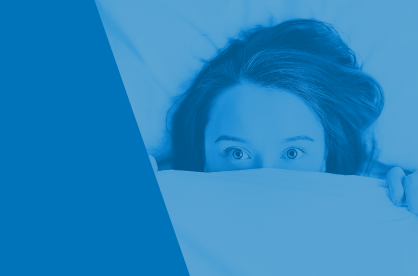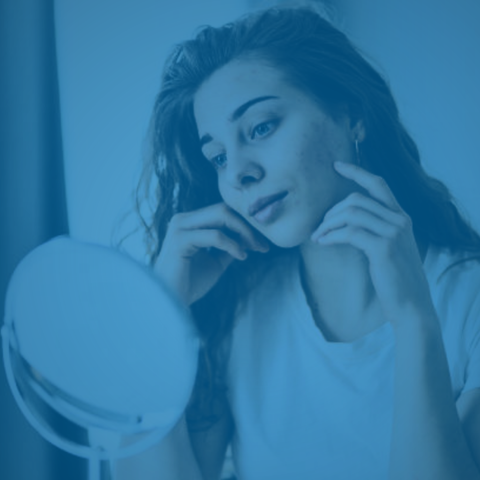
Sleep is a hugely important restorative process for humans as well as all organisms across the animal kingdom. It is absolutely essential for the body, mind, memory, and learning [1].
The brain, in particular, produces metabolic end-products such as reactive oxygen species that can damage and impair the function of brain cells. It is during sleep that these damaging end-products are cleared [2]. In addition, anabolic hormones are preferentially released during sleep (such as the growth hormone) that aid in the physical restoration process.
The short-term effects of sleep disruption include increased stress responsiveness, somatic pain, reduced quality of life, emotional distress and mood disorders, and cognitive, memory, and performance deficits. When prolonged, poor sleep is associated with increased blood pressure, dyslipidemia, cardiovascular disease, issues with body weight control, metabolic disease, type II diabetes, and colorectal cancer [3]. For more on why we sleep, you can read here.
In this article, we will explore eight common sleep challenges and how they affect overall health and well-being, according to the research.
Insomnia
Insomnia is a major public health concern and economic burden that affects up to one-third of the population of the United States [4]. Generally speaking the term describes difficulty in falling and/or staying asleep. It is the most common sleep problem, affecting 10-15% of the general population in the United States, with higher rates seen in females, divorced or separated people, those who have lost loved ones, and older people [5].
When insomnia is chronic, it is linked with an increased risk of depression, anxiety, substance abuse, suicide, motor vehicle accidents, and dysfunction of the immune system [4,6]. You can check out our full article on insomnia here.
Stress
Throughout life there are consistent stressors, some that are positive (eustress), and some that are negative (distress). In recent years, stress levels have increased, particularly in light of the global pandemic, and it has disproportionately affected younger people [7].
When prolonged, chronic negative stress is associated with a reduced volume of the hippocampus and can also change the volume of the amygdala and frontal cortex. There are also potential neurotoxic effects of stress hormones on the brain [8]. Elsewhere in the body, prolonged stress can cause heart problems, gastric ulcers, asthma, diabetes, headaches, accelerated aging, and premature death [9].
Poor quality of sleep is significantly associated with elevated mental stress levels and increased daytime naps too [1]. Other research in medical students (a population known to be affected by stress) [10] has also shown that increased stress levels are a significant predictor of poor sleep quality [11]. Side note: when Dr. Scott from Troscriptions was in medical school, his classmates had shirts made that said, “sleep is for quitters." No wonder why they were always stressed!
Snoring and Sleep Apnea
Snoring is a common cause of disharmony in marriage and relationships. It’s also a well known contributor to social embarrassment [12]. As hard as it might be for partners of snorers to believe, snoring, although potentially loud, is itself not related to measures of sleep structure or subjective sleepiness when measured in a lab setting [13].
However, snoring becomes a more serious issue when it coincides with sleep apnea. Obstructive sleep apnea (OSA) affects 17% of women and 34% of men in the United States [14]. OSA is caused by a number of factors, predominantly the collapse of the airway during sleep from an elevated body mass index (BMI), which leads to pauses in breathing that can last anywhere from seconds to minutes. These episodes can occur a few times a night to hundreds of times, depending on the severity. OSA is usually accompanied by loud snoring and choking sounds as the person resumes breathing. If the pauses in breathing are severe enough, the blood oxygen level will decrease (hypoxemia) and carbon dioxide will increase (hypercapnia).
People with OSA usually wake up feeling unrefreshed and fatigued. This is obviously a huge risk for people working with heavy machinery and other sensitive and/or dangerous equipment [15]. Over the long term, OSA is associated with cardiovascular disease, high blood pressure, heart attacks, strokes, increased risk of cancer, and insulin resistance [16].
Narcolepsy
As a neurological disorder that manifests as excessive daytime sleepiness, narcolepsy is a condition that is often misdiagnosed as a psychiatric disorder or even epilepsy [17]. It is a lifelong disorder that is also associated with irresistible sleep attacks, cataplexy (sudden bilateral loss of muscle tone), hypnagogic (the phase immediately prior to sleep) hallucination, and sleep paralysis [18].
There are two distinct kinds of narcolepsy, one where narcolepsy is accompanied with cataplexy and one where it isn’t.
Unfortunately, there is no cure for narcolepsy, but it can be treated by pharmacological means as well as through lifestyle changes, the latter of which can vastly improvement symptoms at times [18].
Parasomnias
Parasomnias are abnormal behaviors that tend to emanate from or associate with sleep settings. For instance, sleepwalking and related disorders are due to an incomplete dissociation of wakefulness from non-rapid eye movement (NREM) sleep [19]. These abnormal behaviors might include unpleasant verbal and/or physical events during sleep or in the transitory period between being awake and asleep.
Parasomnias can be distressing both for the person and for those around them, and indeed, it tends to be those around them that make the person aware of these behaviors [20].
Blue Light Exposure
Blue light at night – emitted from electronics (like the one you are likely using to read this article!) and energy-efficient lighting are negatively affecting your sleep. As much as a two-hour exposure to blue light (on the 460 nm wavelength) in the evening will suppress melatonin, although this can recover very rapidly after cessation of the exposure (in as little as 15 minutes) [21]. Therefore, limiting blue light exposure in the time immediately preceding sleep is best for promoting quality sleep. Red light is your most optimal wavelength at night, and decreased brightness of all colors in the light spectrum will also help prevent melatonin suppression.
Irregular Sleep Patterns
Having an irregular sleep schedule is a widespread problem, especially in younger people and students. Bedtime sleep irregularity has been associated with a decrease in the average sleep time per day (and therefore sleep quality) [22]. Subsequently, this can also increase daytime sleepiness and fatigue. Keeping the same sleep time and having a consistent schedule every day of the week can therefore improve this aspect of sleep health, particularly for shift workers that have irregular hours [23].
Temperature
In mammals, sleep is associated with a decrease in core body temperature [24]. Temperature itself has a considerable effect on circadian rhythm and sleep quality – it is in fact one of the most important variables. Heat exposure increases wakefulness and decreases slow wave and rapid eye movement sleep. Humid heat exposure further worsens these effects. On the other hand, cold exposure does not affect sleep stages. The use of bedding and clothing during sleep is critical in supporting thermoregulation and sleep in a cold environment [25]. By limiting temperature elevation during sleep, sleep quality can be successfully enhanced and the likelihood of insomnia minimized [26].
Conclusion
Sleep is kind of a big deal and it’s certainly not for quitters. The good news is that there are many ways to improve sleep quality, no matter what challenges you may face. The first step is identifying the issue (or issues). The next is to do your research. Look for simple solutions to remedy said issue or issues (like an eye mask or blue blockers), and, when needed, seek expert consultation. Even formulations like Tro Calm, which helps quiet the mind, may help along the way!
References
[1] A.D. Alotaibi, F.M. Alosaimi, A.A. Alajlan, K.A. Bin Abdulrahman, The relationship between sleep quality, stress, and academic performance among medical students, J Family Community Med. 27 (2020) 23–28. https://doi.org/10.4103/jfcm.JFCM_132_19.
[2] L. Xie, H. Kang, Q. Xu, M.J. Chen, Y. Liao, M. Thiyagarajan, J. O’Donnell, D.J. Christensen, C. Nicholson, J.J. Iliff, T. Takano, R. Deane, M. Nedergaard, Sleep drives metabolite clearance from the adult brain, Science. 342 (2013) 373–377. https://doi.org/10.1126/science.1241224.
[3] G. Medic, M. Wille, M.E. Hemels, Short- and long-term health consequences of sleep disruption, Nat Sci Sleep. 9 (2017) 151–161. https://doi.org/10.2147/NSS.S134864.
[4] P.C. Bollu, H. Kaur, Sleep Medicine: Insomnia and Sleep, Mo Med. 116 (2019) 68–75.
[5] M. Dollander, [Etiology of adult insomnia], Encephale. 28 (2002) 493–502.
[6] D.J. Taylor, K.L. Lichstein, H.H. Durrence, Insomnia as a health risk factor, Behav Sleep Med. 1 (2003) 227–247. https://doi.org/10.1207/S15402010BSM0104_5.
[7] P. Varma, M. Junge, H. Meaklim, M.L. Jackson, Younger people are more vulnerable to stress, anxiety and depression during COVID-19 pandemic: A global cross-sectional survey, Prog Neuropsychopharmacol Biol Psychiatry. 109 (2021) 110236. https://doi.org/10.1016/j.pnpbp.2020.110236.
[8] S.J. Lupien, R.-P. Juster, C. Raymond, M.-F. Marin, The effects of chronic stress on the human brain: From neurotoxicity, to vulnerability, to opportunity, Front Neuroendocrinol. 49 (2018) 91–105. https://doi.org/10.1016/j.yfrne.2018.02.001.
[9] N. Rasheed, Prolonged Stress Leads to Serious Health Problems: Preventive Approaches, Int J Health Sci (Qassim). 10 (2016) V–VI.
[10] K. Prasad, C. McLoughlin, M. Stillman, S. Poplau, E. Goelz, S. Taylor, N. Nankivil, R. Brown, M. Linzer, K. Cappelucci, M. Barbouche, C.A. Sinsky, Prevalence and correlates of stress and burnout among U.S. healthcare workers during the COVID-19 pandemic: A national cross-sectional survey study, EClinicalMedicine. 35 (2021) 100879. https://doi.org/10.1016/j.eclinm.2021.100879.
[11] M. Safhi, R. Alafif, N. Alamoudi, M. Alamoudi, W. Alghamdi, S. Albishri, H. Rizk, The association of stress with sleep quality among medical students at King Abdulaziz University, J Family Med Prim Care. 9 (2020) 1662. https://doi.org/10.4103/jfmpc.jfmpc_745_19.
[12] null Reda, null Ullal, null Wilson, The quality of life impact of snoring and the effect of laser palatoplasty, Clin Otolaryngol Allied Sci. 25 (2000) 570–576. https://doi.org/10.1046/j.1365-2273.2000.00422-11.x.
[13] K.E. Macarthur, T.D. Bradley, C.M. Ryan, H. Alshaer, Dissociation between objectively quantified snoring and sleep quality, Am J Otolaryngol. 41 (2020) 102283. https://doi.org/10.1016/j.amjoto.2019.102283.
[14] D.J. Gottlieb, N.M. Punjabi, Diagnosis and Management of Obstructive Sleep Apnea: A Review, JAMA. 323 (2020) 1389–1400. https://doi.org/10.1001/jama.2020.3514.
[15] H. Celikhisar, G. Dasdemir Ilkhan, The Association of Obstructive Sleep Apnea Syndrome and Accident Risk in Heavy Equipment Operators, Medicina (Kaunas). 55 (2019) E599. https://doi.org/10.3390/medicina55090599.
[16] D.C. Lim, A.I. Pack, Obstructive Sleep Apnea: Update and Future, Annu Rev Med. 68 (2017) 99–112. https://doi.org/10.1146/annurev-med-042915-102623.
[17] E.I. Koziorynska, A.J. Rodriguez, Narcolepsy: clinical approach to etiology, diagnosis, and treatment, Rev Neurol Dis. 8 (2011) e97-106.
[18] G.S. Akintomide, H. Rickards, Narcolepsy: a review, Neuropsychiatr Dis Treat. 7 (2011) 507–518. https://doi.org/10.2147/NDT.S23624.
[19] M.J. Howell, Parasomnias: an updated review, Neurotherapeutics. 9 (2012) 753–775. https://doi.org/10.1007/s13311-012-0143-8.
[20] S. Singh, H. Kaur, S. Singh, I. Khawaja, Parasomnias: A Comprehensive Review, Cureus. 10 (2018) e3807. https://doi.org/10.7759/cureus.3807.
[21] L. Tähkämö, T. Partonen, A.-K. Pesonen, Systematic review of light exposure impact on human circadian rhythm, Chronobiol Int. 36 (2019) 151–170. https://doi.org/10.1080/07420528.2018.1527773.
[22] J.-H. Kang, S.-C. Chen, Effects of an irregular bedtime schedule on sleep quality, daytime sleepiness, and fatigue among university students in Taiwan, BMC Public Health. 9 (2009) 248. https://doi.org/10.1186/1471-2458-9-248.
[23] A.H. Garde, L. Begtrup, B. Bjorvatn, J.P. Bonde, J. Hansen, Å.M. Hansen, M. Härmä, M.A. Jensen, G. Kecklund, H.A. Kolstad, A.D. Larsen, J.A. Lie, C.R. Moreno, K. Nabe-Nielsen, M. Sallinen, How to schedule night shift work in order to reduce health and safety risks, Scand J Work Environ Health. 46 (2020) 557–569. https://doi.org/10.5271/sjweh.3920.
[24] R. Szymusiak, Body temperature and sleep, Handb Clin Neurol. 156 (2018) 341–351. https://doi.org/10.1016/B978-0-444-63912-7.00020-5.
[25] K. Okamoto-Mizuno, K. Mizuno, Effects of thermal environment on sleep and circadian rhythm, J Physiol Anthropol. 31 (2012) 14. https://doi.org/10.1186/1880-6805-31-14.
[26] L.C. Lack, M. Gradisar, E.J.W. Van Someren, H.R. Wright, K. Lushington, The relationship between insomnia and body temperatures, Sleep Med Rev. 12 (2008) 307–317. https://doi.org/10.1016/j.smrv.2008.02.003.






Comments (0)
There are no comments for this article. Be the first one to leave a message!